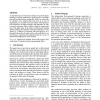Free Online Productivity Tools
i2Speak
i2Symbol
i2OCR
iTex2Img
iWeb2Print
iWeb2Shot
i2Type
iPdf2Split
iPdf2Merge
i2Bopomofo
i2Arabic
i2Style
i2Image
i2PDF
iLatex2Rtf
Sci2ools
ACE
2003
2003
Successful Studio-based Real-World Projects in IT Education
An important aspect of University teaching is to promote deeper learning by ensuring students have good exposure to problems they will encounter in their working life. While it is not possible to reproduce every situation that will occur in an area of employment, it is possible to provide students with experience from which they can utilise principles and approaches in order to gain the necessary skills to address whatever scenario may arise. This paper looks at the nature of studio-based teaching and the pedagogy that supports it, through examining two case studies as a catalyst for exploring real-world projects. It is through the discussion of aspects such as real-world clients, user involvement, sequencing and integration that the success of studio-based teaching in IT can be revealed.1
| Added | 31 Oct 2010 |
| Updated | 31 Oct 2010 |
| Type | Conference |
| Year | 2003 |
| Where | ACE |
| Authors | Matthew Simpson, Jay Burmeister, Alan Boykiw, Jihan Zhu |
Comments (0)

